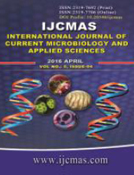


 National Academy of Agricultural Sciences (NAAS)
National Academy of Agricultural Sciences (NAAS)

|
PRINT ISSN : 2319-7692
Online ISSN : 2319-7706 Issues : 12 per year Publisher : Excellent Publishers Email : editorijcmas@gmail.com / submit@ijcmas.com Editor-in-chief: Dr.M.Prakash Index Copernicus ICV 2018: 95.39 NAAS RATING 2020: 5.38 |
Drug resistance among Staphylococcus aureus is an increasing problem. Clindamycin is one of the effective antibiotic for treating both methicillin sensitive and resistant Staphylococcal infections. A major concern regarding the use of clindamycin therapy is the presence of inducible resistance. In vitro routine tests for clindamycin susceptibility may fail to detect inducible resistance resulting in treatment failure. The present study aimed to find out the inducible clindamycin resistance in the clinical isolates of Staphylococcus aureus using D test. The study was conducted at the Department of Microbiology in Sree Narayana Institute of Medical Sciences, Kerala over a period of one year. All of the total 220 S.aureus isolates during the period were included in the study. D test was done in the erythromycin resistant strains as per CLSI guidelines. Inducible clindamycin resistance was observed in 12.7%, constitutive resistance in 8.1% and MS phenotype in 41.8% of the total isolates. The rate of MRSA and MSSA were 41.8% and 58.2% respectively. Inducible resistance and constitutive resistance were higer in MRSA (34.8% and 10.9% respectively) as compared to MSSA where the inducible resistance was only 3.1% and no constitutive resistance was noticed. 19.6% of MRSA and 21.9% of MSSA showed MS phenotype. Inducible clindamycin resistance was more common than constitutive resistance in our hospital. Both inducible and constitutive resistance showed higher incidence among MRSA than MSSA. The trends in resistance may vary from place to place. So D- test should be done routinely to delineate different resistant phenotypes in the laboratory to help clinicians for the judicious use of clindamycin in order to avoid therapeutic failure as well as irrational use of higher antibiotics.
 |
 |
 |
 |
 |